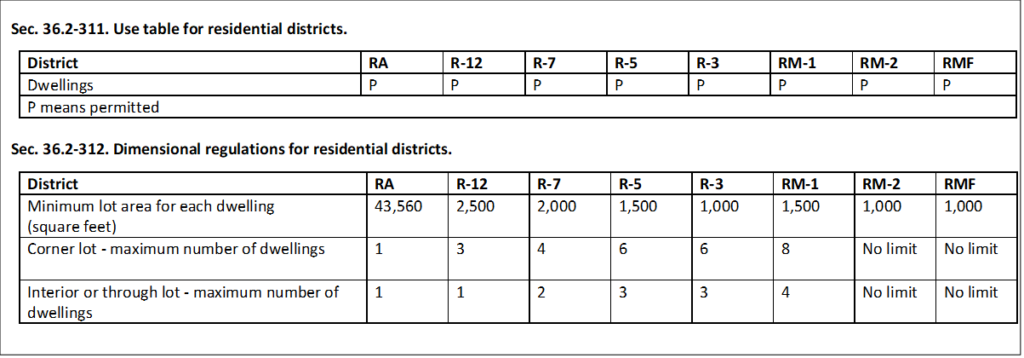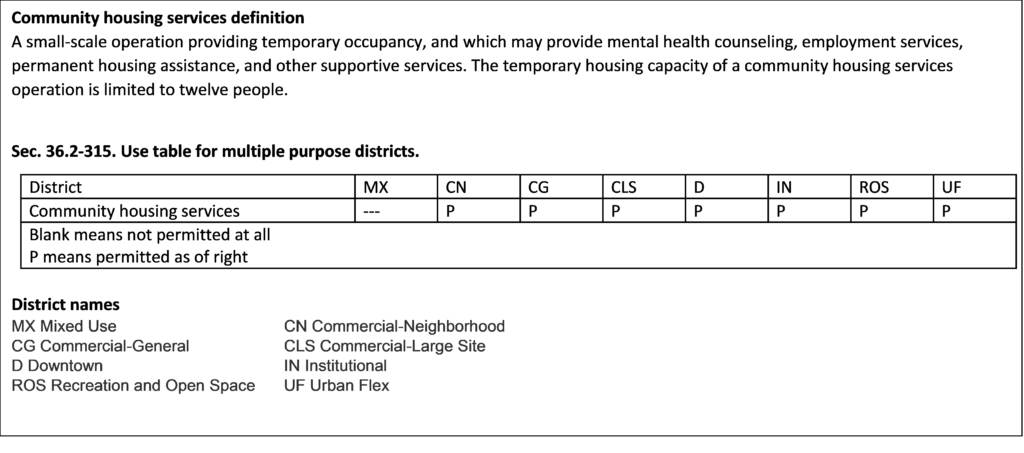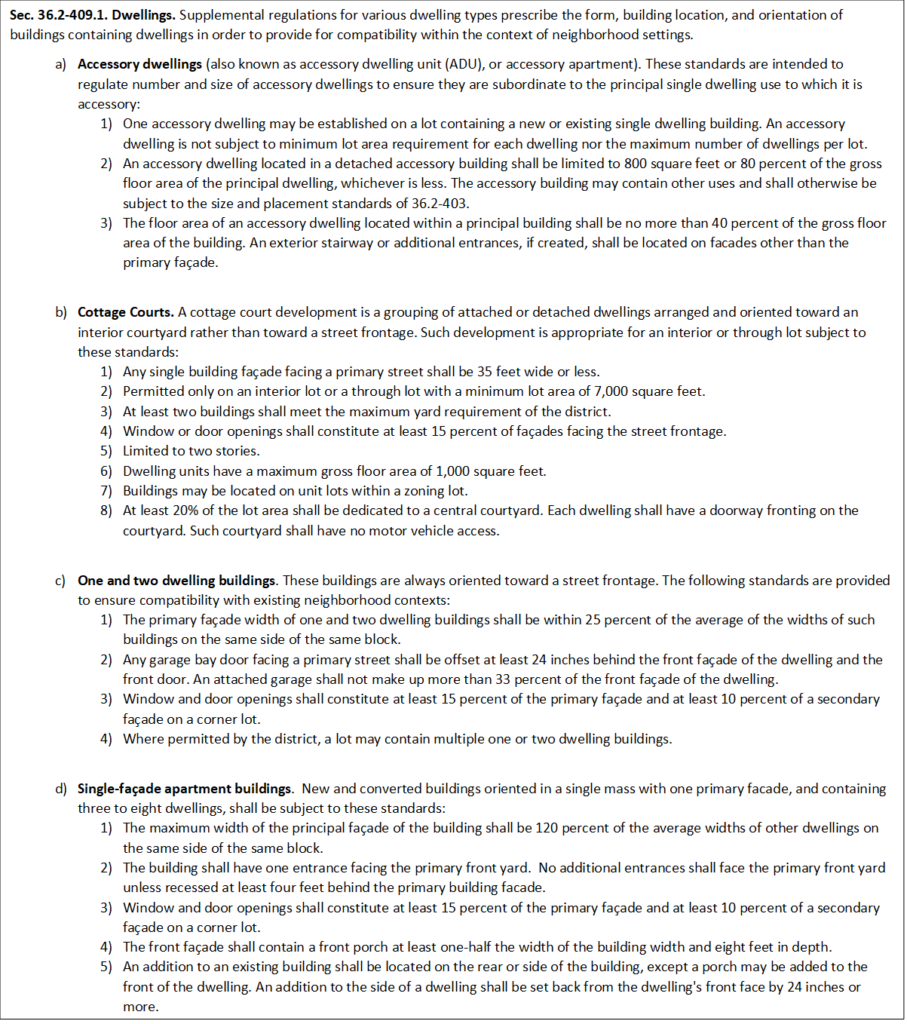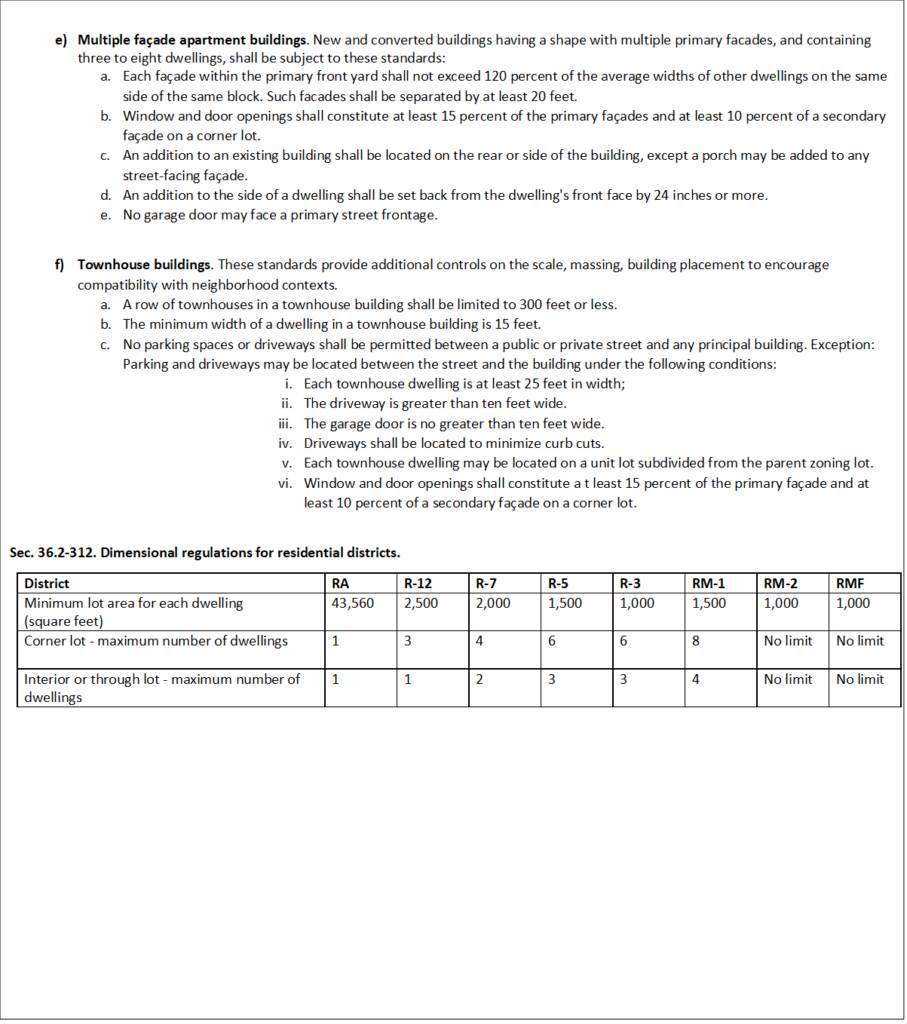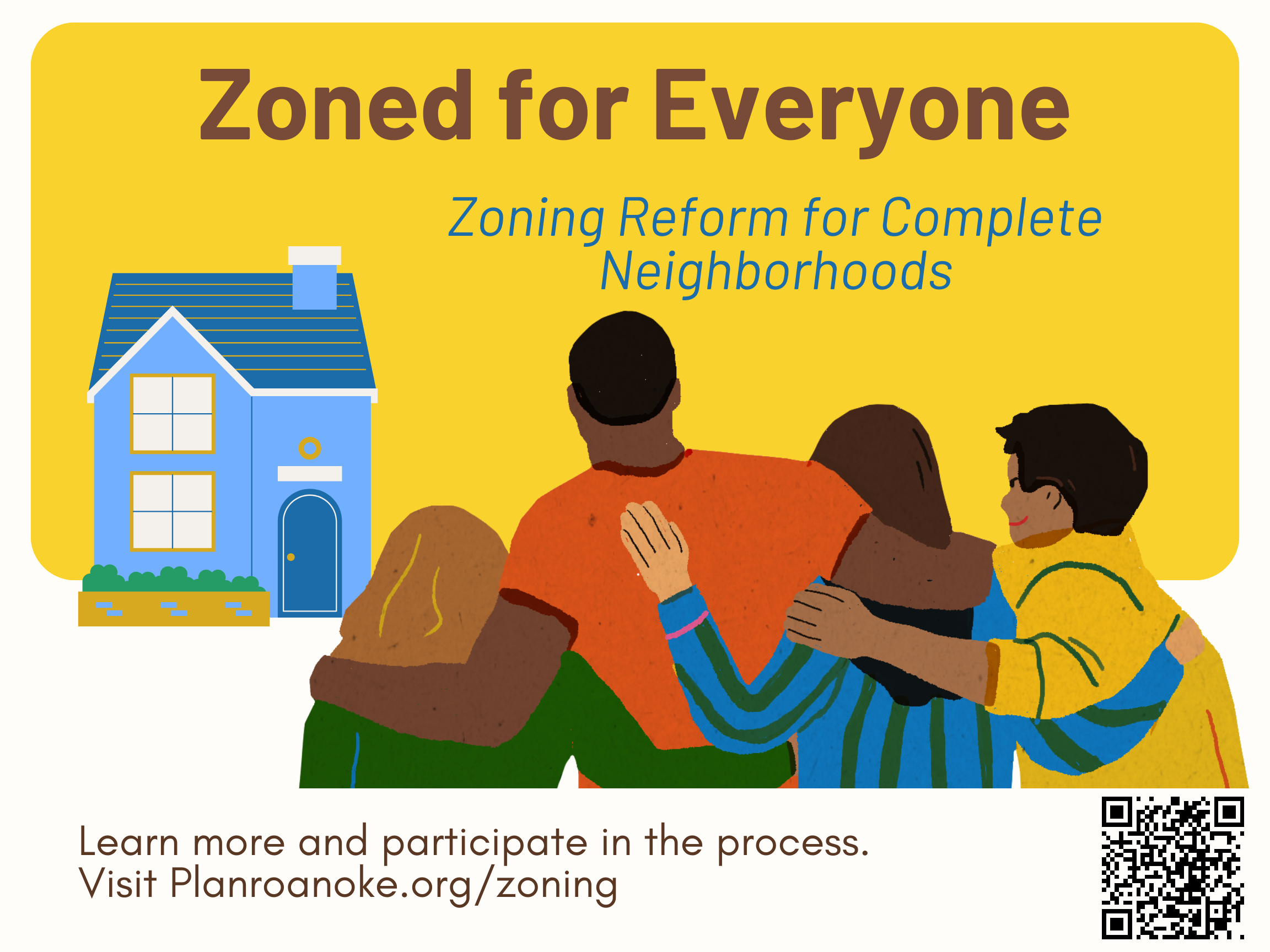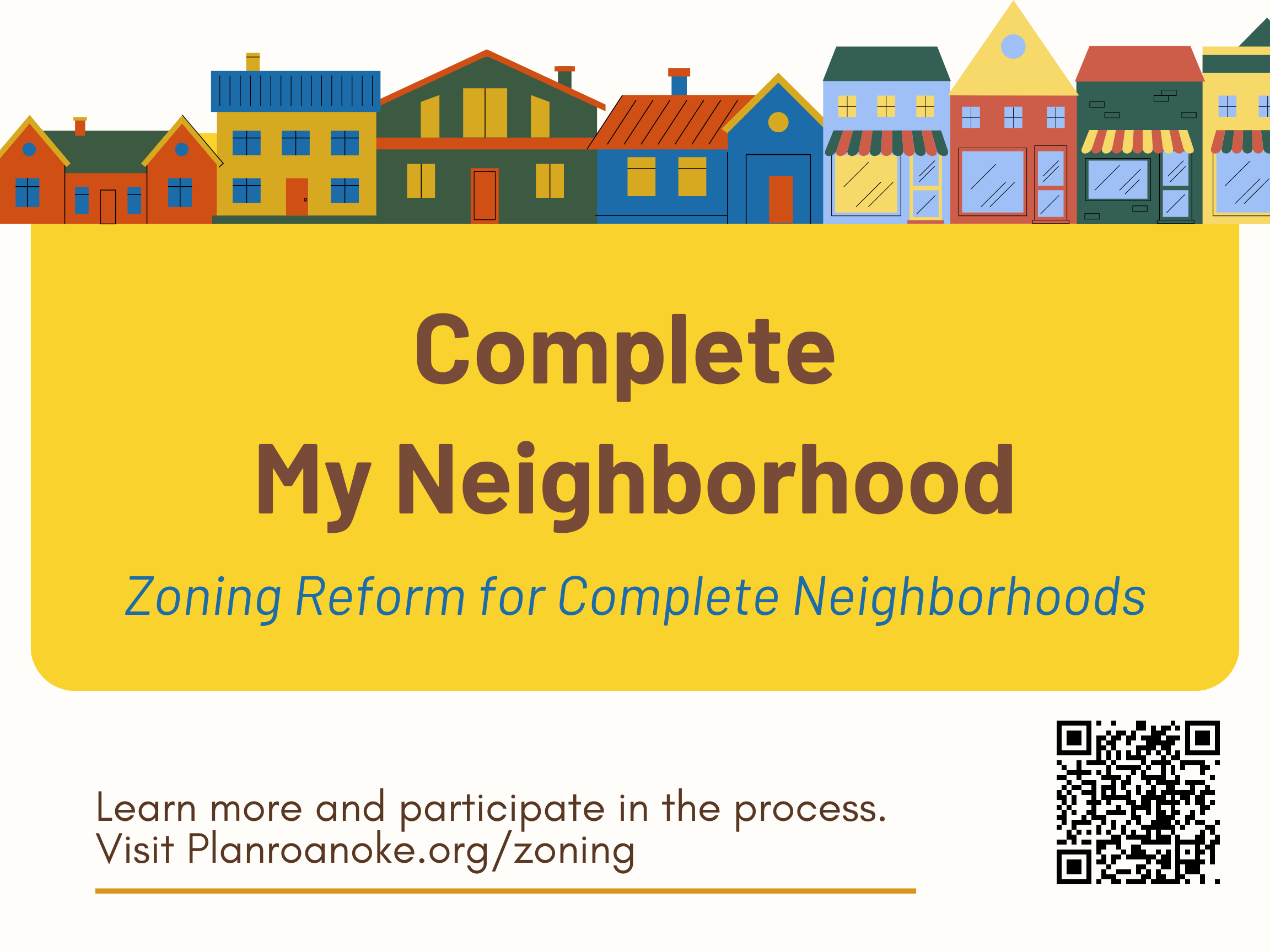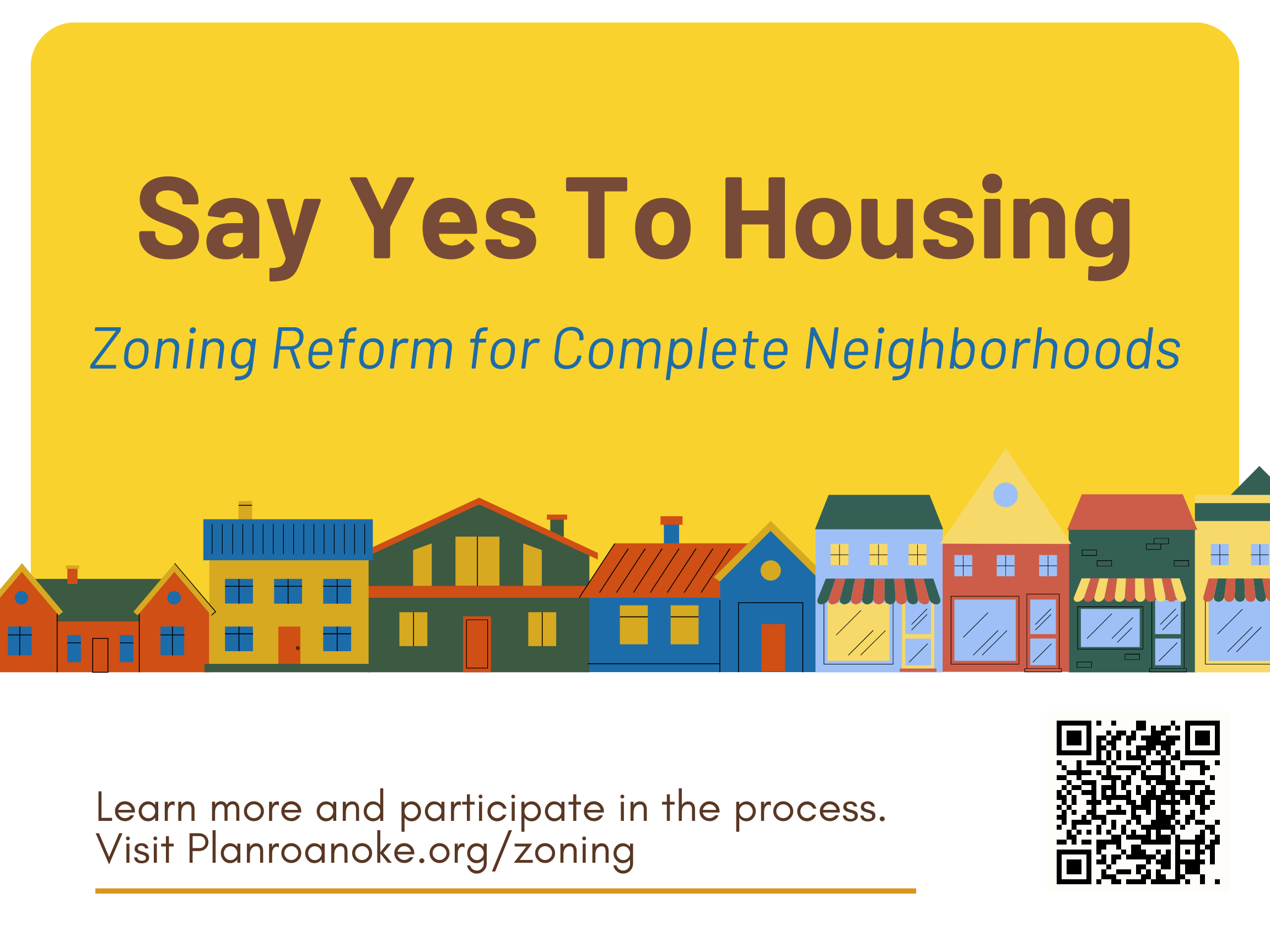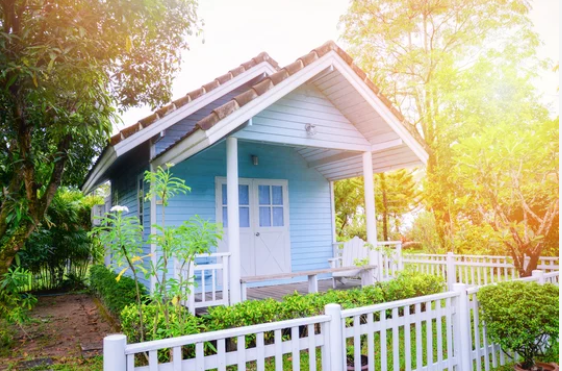Update: Clarification on Zoning Amendments
Roanoke City Council enacted Zoning Amendments on September 16, 2024, to expand housing options in the City of Roanoke. These Zoning Amendments are similar in substance to the Zoning Amendments adopted by City Council on March 18, 2024. The proposed amendments are linked below, and a physical copy is available for public inspection in the Office of the City Clerk, Suite 456, Noel C. Taylor Municipal Building, 215 Church Avenue SW, Roanoke, Virginia, 24011.
- Zoning Amendments: Adopted Ordinance
- Zoning Amendments: Report to City Council
- Summary of text amendments
- Zoning Amendments: Amendments compared to the March 18,2024 zoning code
- Zoning Amendments: Amendments compared to pre-March 18, 2024 zoning code
On Monday, June 17,2024 City Council adopted a Resolution initiating a process to reconsider and readopt the Zoning Amendments enacted on March 18,2024. The reconsideration and action on the Zoning Amendments was in response to litigation filed; this reconsideration process allowed the City to benefit from additional public comment and review. The City issued notices for the public hearings based on new and clarified public notice provisions in the Code of Virginia in effect as of July 1, 2024.
Reconsideration of the Zoning Amendments, public hearings on the Zoning Amendments, and action on the Zoning Amendments by Planning Commission and City Council occurred as follows:
- Planning Commission Public Hearing | August 12, 2024, at 1:30 p.m. in City Council Chambers
- Roanoke City Council Public Hearing | September 16, 2024, 7 p.m. in City Council Chambers
A briefing on the Zoning Amendments was presented to Planning Commission and City Council on Monday, August 5, 2024. The presentation and report are linked below:
- Briefing to Planning Commission and City Council | Neighborhood Briefing
- Zoning Amendments Report and Study
The City of Roanoke held two public information meetings on the zoning amendments adopted in March 2024 and the process directed by City Council to address procedural concerns. Meetings began with a brief presentation and were followed by a listening session to record concerns and questions.
Zoning Reform for Complete Neighborhoods
Roanoke City Council has approved zoning reform for complete neighborhoods through amendments to the zoning ordinance that expand housing opportunities. Watch the video below for a summary of the amendments. Click the links to view the approved Ordinance and Report.
These text amendments are the second in a series and will continue to address priorities, policies, and actions of City Plan 2040. Priorities include:
The amendments remove exclusionary zoning practices, implement the comprehensive plan, and remove regulatory barriers to housing opportunities. Below are the general descriptions of the changes to the zoning code. Click here view a summary pdf of the proposed amendments.
Ways to get involved:
The following opportunities for involvement in the text amendment process were made available.
1. Open House Meetings
Several rounds of Open House Meetings were held at each of the City’s public libraries.
The City of Roanoke held two public information meetings on the zoning amendments adopted in March 2024 and the process directed by City Council to address procedural concerns. Meetings began with a brief presentation and were followed by a listening session to record concerns and questions.
- Tuesday August 27th, 2024
6-8 p.m.
Melrose Branch Library
2502 Melrose Ave NW Suite D, Roanoke, VA 24017
- Thursday August 29th, 2024
6-8 p.m.
Belmont Branch Library
1101 Morningside St SE, Roanoke, VA 24013
Additional Meetings:
- Tuesday August 13th, 2024
7-9 p.m.
SpringHill Suites, 301 Reserve Ave SW, Roanoke, VA 24016
Organized by Neighbors in South Roanoke
- Tuesday September 3rd, 2024
6-8 p.m.
Raleigh Court Branch Library
2112 Grandin Rd SW, Roanoke, VA 24015
Organized by the Raleigh Court Civic League
2. Campaigns
Free yard signs and a t-shirt campaign were created to spread awareness.
3. Online Meetings and Forms
Virtual meetings and online forms were made available throughout the process for those unable to attend meetings in person.
4. Public Hearings
Public hearings were held by both Planning Commission and City Council as part of the text amendment process. Sign up for meeting notifications via MyRoanoke.
Projected Timeline:
- Planning Commission Public Hearing | March 11th, 2024
- City Council Public Hearing | March 18th, 2024
On Monday, June 17,2024 City Council adopted a Resolution initiating a process to reconsider and readopt the Zoning Amendments. The reconsideration and action on the Zoning Amendments is in response to litigation filed; this reconsideration process allows the City to benefit from additional public comment and review. The City issued notices for the public hearings based on new and clarified public notice provisions in the Code of Virginia in effect as of July 1, 2024.
- Planning Commission Public Hearing | August 12th, 2024
- City Council Public Hearing | September 16th, 2024
Say Yes to Housing!
Sign Campaign – Closed
The City of Roanoke used a sign campaign to promote text amendments that expand housing opportunities. Free signs were made available at the Fall Open House Meetings, in the Permit Center at 215 Church Avenue SW, Room 170, and at the Roanoke City Library Branches.
Shirt Campaign
If you are interested in getting your own Say Yes to Housing! shirt, click here to visit the PlanRoanoke campaign on Bonfire.
Frequently Asked Questions
Helpful resources are included below to provide more information on housing needs within the City of Roanoke and nationwide.
Local
- Citywide Housing Study – City of Roanoke, VA
- City Plan 2040
- Age Friendly Roanoke Action Plan
- Point in Time Count
National
Phillip Moore, Zoning Administrator, and Planning staff, in coordination with Lauren Waldron, Community Engagement Manager, and Josh Johnson, Neighborhood Services Coordinator, produced a live event, “Zoning Text Amendments Q&A Session,” on October 28th, 2021.
2021 Text Amendment Timeline:
- November 1st, City Council Briefing
- November 8th, Planning Commission Public Hearing
- November 15th, City Council Public Hearing
These text amendments were the first in a series and completed the following actions of City Plan 2040:
Update: Clarification on Zoning Amendments
Roanoke City Council enacted Zoning Amendments on September 16, 2024, to expand housing options in the City of Roanoke. These Zoning Amendments are similar in substance to the Zoning Amendments adopted by City Council on March 18, 2024. The proposed amendments are linked below, and a physical copy is available for public inspection in the Office of the City Clerk, Suite 456, Noel C. Taylor Municipal Building, 215 Church Avenue SW, Roanoke, Virginia, 24011.
- Zoning Amendments: Adopted Ordinance
- Zoning Amendments: Report to City Council
- Summary of Text Amendments
- Zoning Amendments: Amendments compared to the March 18,2024 zoning code
- Zoning Amendments: Amendments compared to pre-March 18, 2024 zoning code
On Monday, June 17,2024 City Council adopted a Resolution initiating a process to reconsider and readopt the Zoning Amendments enacted on March 18,2024. The reconsideration and action on the Zoning Amendments was in response to litigation filed; this reconsideration process allowed the City to benefit from additional public comment and review. The City issued notices for the public hearings based on new and clarified public notice provisions in the Code of Virginia in effect as of July 1, 2024.
Reconsideration of the Zoning Amendments, public hearings on the Zoning Amendments, and action on the Zoning Amendments by Planning Commission and City Council occurred as follows:
- Planning Commission Public Hearing | August 12, 2024, at 1:30 p.m. in City Council Chambers
- Roanoke City Council Public Hearing | September 16, 2024, 7 p.m. in City Council Chambers
A briefing on the Zoning Amendments was presented to Planning Commission and City Council on Monday, August 5, 2024. The presentation and report are linked below:
- Briefing to Planning Commission and City Council | Neighborhood Briefing
- Zoning Amendments Report and Study
The City of Roanoke held two public information meetings on the zoning amendments adopted in March 2024 and the process directed by City Council to address procedural concerns. Meetings began with a brief presentation and were followed by a listening session to record concerns and questions.
Zoning Reform for Complete Neighborhoods
Roanoke City Council has approved zoning reform for complete neighborhoods through amendments to the zoning ordinance that expand housing opportunities. Watch the video below for a summary of the amendments. Click the links to view the approved Ordinance and Report.
These text amendments are the second in a series and will continue to address priorities, policies, and actions of City Plan 2040. Priorities include:
The amendments remove exclusionary zoning practices, implement the comprehensive plan, and remove regulatory barriers to housing opportunities. Below are the general descriptions of the changes to the zoning code. Click here view a summary pdf of the proposed amendments.
Ways to get involved:
The following opportunities for involvement in the text amendment process were made available.
1. Open House Meetings
Several rounds of Open House Meetings were held at each of the City’s public libraries.
The City of Roanoke held two public information meetings on the zoning amendments adopted in March 2024 and the process directed by City Council to address procedural concerns. Meetings began with a brief presentation and was followed by a listening session to record concerns and questions.
- Tuesday August 27th, 2024
6-8 p.m.
Melrose Branch Library
2502 Melrose Ave NW Suite D, Roanoke, VA 24017
- Thursday August 29th, 2024
6-8 p.m.
Belmont Branch Library
1101 Morningside St SE, Roanoke, VA 24013
Additional Meetings:
- Tuesday August 13th, 2024
7-9 p.m.
SpringHill Suites, 301 Reserve Ave SW, Roanoke, VA 24016
Organized by Neighbors in South Roanoke
- Tuesday September 3rd, 2024
6-8 p.m.
Raleigh Court Branch Library
2112 Grandin Rd SW, Roanoke, VA 24015
Organized by the Raleigh Court Civic League
2. Campaigns
Free yard signs and a t-shirt campaign were created to spread awareness.
3. Online Meetings and Forms
Virtual meetings and online forms were made available throughout the process for those unable to attend meetings in person.
4. Public Hearings
Public hearings were held by both Planning Commission and City Council as part of the text amendment process. Sign up for meeting notifications via MyRoanoke.
Projected Timeline:
- Planning Commission Public Hearing | March 11th, 2024
- City Council Public Hearing | March 18th, 2024
On Monday, June 17,2024 City Council adopted a Resolution initiating a process to reconsider and readopt the Zoning Amendments. The reconsideration and action on the Zoning Amendments was in response to litigation filed; this reconsideration process allowed the City to benefit from additional public comment and review. The City will issued notices for the public hearings based on new and clarified public notice provisions in the Code of Virginia in effect as of July 1, 2024.
- Planning Commission Public Hearing | August 12th, 2024
- City Council Public Hearing | September 16th, 2024
Say Yes to Housing!
Sign Campaign – Closed
The City of Roanoke used a sign campaign to promote text amendments that expand housing opportunities. Free signs were made available at the Fall Open House Meetings, in the Permit Center at 215 Church Avenue SW, Room 170, and at the Roanoke City Library Branches.
Shirt Campaign
If you are interested in getting your own Say Yes to Housing! shirt, click here to visit the PlanRoanoke campaign on Bonfire.
Helpful resources are included below to provide more information on housing needs within the City of Roanoke and nationwide.
Local
- Citywide Housing Study – City of Roanoke, VA
- City Plan 2040
- Age Friendly Roanoke Action Plan
- Point in Time Count
National
Frequently Asked Questions
Phillip Moore, Zoning Administrator, and Planning staff, in coordination with Lauren Waldron, Community Engagement Manager, and Josh Johnson, Neighborhood Services Coordinator, produced a live event, “Zoning Text Amendments Q&A Session,” on October 28th, 2021.
2021 Text Amendment Timeline:
- November 1st, City Council Briefing
- November 8th, Planning Commission Public Hearing
- November 15th, City Council Public Hearing
These text amendments were the first in a series and completed the following actions of City Plan 2040:


